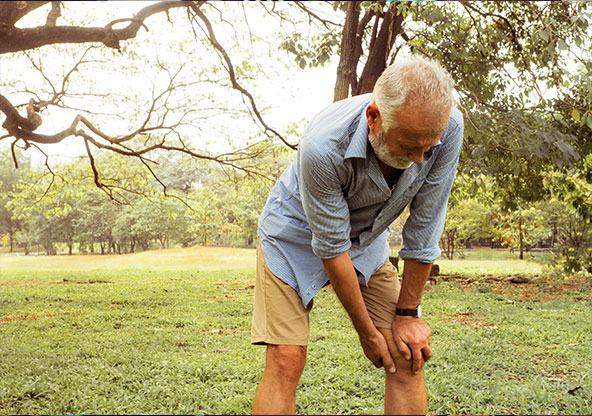Understanding Severe Joint Pain
How to Know if Your Joint Pain is Serious
Your joints are involved in almost every activity you do. However, hip or knee pain limits your range of motion, your work and the things you enjoy. Knowing the signs and symptoms of severe joint pain can help you decide when to seek help.
This article covers the following:
- How to determine how much your joint pain affects your quality of life.
- If you have joint pain, you most likely have osteoarthritis, the most common form of arthritis.
- What are your non-surgical treatment options?
- Risks of not treating your joint pain.
Can you do what you want to do?
One of the first things an orthopedic surgeon will look at is whether you can reasonably do what you want. For example, if you cannot play with your grandkids, play a round of golf or go to the park, then arthritis has probably become a problem.
If you're having problems doing the things that you want to do, you probably have some element of arthritis. These are simple daily living activities, like getting out of bed, going up and down stairs, housework, getting into or out of a car, kneeling, squatting, and not being able to walk as far as you want to.
Do You have severe joint pain at night?
Orthopedic surgeons will also ask their patients if joint pain affects their sleep. Do aching joints at night prevent you from falling asleep, or does severe knee pain at night wake you up? If so, it is a problem for a couple of reasons. First, it indicates that something more serious is happening to your joints. Second, not sleeping enough can lead to gaining weight and weakening your immune system.
Did You Know?
In the United States:
- Close to three in ten adults have problems with their joints, and 21% of those have arthritis.
- 54 million people have been diagnosed by a doctor with arthritis.
- Arthritis is the most common cause of work disability.
- There are more than 700,000 knee replacements in the United States and more than 325,000 hip replacements.
- Knee replacements are more common than hip replacements.
Types of Arthritis
So the three big broad categories inflammatory arthritis, degenerative or osteoarthritis, and post-traumatic arthritis.
-
The most common is what we call osteoarthritis or degenerative arthritis.
-
You also have post-traumatic arthritis where there's a trauma to the joint, and there's a joint deformity, and it's uneven. It's either post-surgical or trauma-related; we consider surgery trauma, where there's damage to the cushion called the meniscus or the articular surface. And in you get abnormal wear patterns.
-
The third type of arthritis is inflammatory arthritis. The most common is rheumatoid arthritis. It's a condition when the immune system attacks the body's joints and destroys the body's cartilage, such as the knee articular cartilage.
How Arthritis is Identified
Orthopedic surgeons identify arthritis with physical examination, X-rays, and sometimes with an MRI, lab tests or CT scans. However, most often, surgeons identify arthritis in the joints with X-rays and physical examination.
What surgeons usually see on X-rays is space between the bones. When that space is gone, bone touches bone. That's, by definition, arthritis.
What happens to the body when you get arthritis?
When you get arthritis, certain things happen along with it. First, you can get bone spurs, which are extra bone. This is like a callus on your skin but formed on bones.
Extra bone is bone spurs or osteophytes. That's a sign of arthritis.
You'll also get hardening of the bone called sclerosis. You might also have some cysts in the bone due to overuse and activity.
What Causes Joint Pain?
Joint pain can appear suddenly or develop over weeks, months or years. Some conditions may be temporary, others long-lasting. Conditions that cause joint pain include:
- Ankylosing spondylitis: A type of arthritis, ankylosing spondylitis typically affects the spine, although other joints may also be affected. Pain and stiffness in the lower back and hips are common.
- Bursitis: Bursitis is inflammation of small sacs called bursae that serve as buffers between bones and tissues so joints can move smoothly. Common symptoms of bursitis include pain and swelling.
- Injury: A sprain or fracture can cause acute joint pain.
- Osteoarthritis is the most common type of arthritis. This condition occurs when the cartilage in a joint wears away, leaving nothing to cushion bones during movement. That can cause joint swelling and pain. Osteoarthritis is common in the knees and hips but can affect any joint.
- Osteomyelitis: Osteomyelitis is a bone infection that can cause pain and swelling around a joint.
- Reactive arthritis: This condition causes joint inflammation, often in the knees and ankles. Reactive arthritis can occur when your body responds to a bacterial infection.
- Septic arthritis. Caused by a bacterial or fungal infection of a joint, septic arthritis can lead to joint swelling and intense pain, among other symptoms. This condition commonly affects the hips and knees.
- Systemic lupus erythematosus (SLE). The most common type of lupus, SLE is a condition in which the immune system attacks joints and organs. Symptoms typically come and go. During a flare, joint pain and swelling may occur, along with fatigue and skin rashes.
- Tendinitis. Performing the same movement over and over, such as swinging a tennis racket, can cause inflammation of a tendon. That’s tendinitis. This condition can cause pain and tenderness around a joint.
On Osteoarthritis
Osteoarthritis is just regular wear and tear, usually in older adults. Joints have cartilage, where two bones meet to protect them from rubbing against each other,
Wear and tear in damaged joints is similar to bald car tires. After 50,000 miles, tire treads start to become thin. The same is true with cartilage on the end of the joints. Cartilage gets worn out.
Almost all babies have cartilage covering the end of the bone. With time, use and trauma, the cartilage wears. As a result, bones in joints become exposed to one another and can begin rubbing on each other. It can feel irritating, like sandpaper rubbing on sandpaper.
Non-surgical options to relieve pain
- For arthritis of the hip and knee, you can use walking aids or braces that may allow you to put less pressure on the affected joint.
- Try heat or cold therapy.
- Try physical therapy, where you can strengthen the muscles around the affected joint to compensate for any issues.
- You can try over-the-counter or prescription anti-inflammatory medications to help with inflammation, like ibuprofen or steroid medications.
- Steroid injections, like a SI Joint Injection, are like a high dose of Motrin inside the joint. Injections are lubricants but are not a cure. You still have arthritis, but as long as it doesn't bother you and you can do what you want, you don't need surgery.
However, if these non-surgical treatments do not work and your joints still bother you, you're a candidate for joint surgery.
Risks of Avoiding Severe Joint Pain
If someone has tried all non-surgical treatments and doesn’t want joint replacement surgery, they will still have pain. This pain will most likely prevent them from participating in life events and cause them to be less active.
When a joint hurts, you can become less active. If it hurts to walk or get out of bed, exercising will be even more difficult.
In extreme cases, when you don't exercise, you tend to get heavier. As an older person, your heart must work harder. If the joint is not fixed and you don't exercise, you can get heart disease or diabetes.
Some people needing joint replacement have had heart disease, diabetes, or a heart attack. The doctors will tell them to exercise, but they can't because their knee hurts.
It starts a vicious cycle. As you age and get arthritis and don't replace the joint, it can start a cascade of events that can pile up on you if you're not careful.
Is Your Joint Pain Normal?
Take our free assessment to investigate if your joint pain is normal. You will receive information about your joint health, what you can do at home, and when professional treatment is needed.


